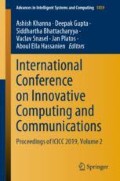Abstract
In vehicular drivers, the cognitive fatigue has been one of the major factors that leads to loss of lives or disabilities due to vehicular accidents (Bundele and Banerjee in Proceedings of the 11th international conference on information integration and web-based applications and services, ACM, pp 739–744, 2009 [1]). The factors governing driver fatigue such as monotonous driving, traffic conditions on road, road conditions, insufficient sleep, anxiety, health conditions, work environment, type of vehicle, and driving comfort do affect largely the driving behavior. Many researchers across the world are working finding best suitable methods to minimize vehicular accidents. In this paper, our proposed approach is an alternative solution to detect cognitive fatigue in vehicular drivers to decrease the number of incidence of vehicular accidents specially those occurred due to cognitive fatigue (Hu and Zheng in Expert Syst Appl 36:7651–7658, 2009 [2]). The objective of this work has been to provide simple classification technique using K-means algorithms. The basic K-means and two modified versions have been proposed and validated to reliably detect cognitive fatigue while driving. It is of paramount importance that the sensory parameters are chosen such that they could be used without causing discomfort to the driver and without creating obstruction while driving. The data for simple physiological signals such as skin conductance (SC), oximetry pulse (OP), and respiration (RSP) for pre- and post-driving state of drivers has been used for sensing change in fatigue level of the drivers (Bundele and Banerjee in 2009 second international conference on emerging trends in engineering & technology. IEEE, pp 934–939, 2009 [3]). All features of statistical and wavelet were extracted and analyzed (Brown in D1 Methodological issues in driver fatigue research. Fatigue and driving: driver impairment, driver fatigue, and driving simulation, p 155, 1995 [4]). Selected features were used as input to the classifiers designed and implemented using basic K-means and two modified versions. Finally, comparative performance analysis of classifiers and the features is discussed. This paper discusses prominent results obtained during experimentation. Further the maximum classification accuracy could be produced by these features, so as to reduce the computational complexity (Bundele and Banerjee in Proceedings of the 11th international conference on information integration and web-based applications and services, ACM, pp 739–744, 2009 [1]). It could be found that a smaller set of features could provide the correctness of fatigue detection.
Access this chapter
Tax calculation will be finalised at checkout
Purchases are for personal use only
References
Bundele MM, Banerjee R (2009) Detection of fatigue of vehicular driver using skin conductance and oximetry pulse: a neural network approach. In: Proceedings of the 11th international conference on information integration and web-based applications and services. ACM, pp 739–744
Hu S, Zheng G (2009) Driver drowsiness detection with eyelid related parameters by support vector machine. Expert Syst Appl 36(4):7651–7658. www.elsevier.com/locate/eswa
Bundele MM, Banerjee R (2009) An SVM classifier for fatigue-detection using skin conductance for use in the BITS-Lifeguard wearable computing system. In: 2009 second international conference on emerging trends in engineering and technology. IEEE, pp 934–939
Brown I (1995) D1Methodological issues in driver fatigue research. Fatigue and driving: driver impairment, driver fatigue, and driving simulation, p 155
Yeo MVM, Li X, Shen K, Wilder-Smith EPV (2009) Can SVM be used for automatic EEG detection of drowsiness during car driving? Saf Sci 47(1):115–124
Yang G, Yingzi L, Bhattacharya P (2005) A driver fatigue recognition model using fusion of multiple features. In: 2005 IEEE international conference on systems, man and cybernetics, vol 2. IEEE, pp 1777–1784
Sharma MK, Bundele MM (2005) Design & analysis of performance of K-means algorithm for cognitive fatigue detection in vehicular drivers using skin conductance signal. In: 2015 2nd international conference on computing for sustainable global development (INDIACom), IEEE, pp 707–712
Zhang C, Zheng C-X, Yu X-L (2009) Automatic recognition of cognitive fatigue from physiological indices by using wavelet packet transform and kernel learning algorithms. Expert Syst Appl 36(3):4664–4671. www.elsevier.com/locate/eswa
Eoh HJ, Chung MK, Kim S-H (2005) Electroencephalographic study of drowsiness in simulated driving with sleep deprivation. Int J Ind Ergon 35(4):307–320. www.elsevier.com/locate/ergon
Bundele MM (2008) Identification of body parameters for changes in reflexes of a vehicular driver under drowsiness/fatigue/stress conditions. Published in the proceeding of Frontier, pp 123–131
Shen K-Q, Ong C-J, Li X-P, Hui Z, Wilder-Smith EPV (2007) A feature selection method for multilevel mental fatigue EEG classification. IEEE Trans Biomed Eng 54(7):1231–1237
Sharma MK, Bundele MM (2015) Design & analysis of k-means algorithm for cognitive fatigue detection in vehicular driver using oximetry pulse signal. In: 2015 international conference on computer, communication and control (IC4). IEEE, pp 1–6
Acknowledgements
It is great pleasure to acknowledge the vehicular drivers to allow us for collecting the real-time data in this research work. We also wish to extend our sincere thanks to Poornima University and Poornima College of Engineering, Jaipur, for providing us good environment for work and good management.
Author information
Authors and Affiliations
Corresponding author
Editor information
Editors and Affiliations
Rights and permissions
Copyright information
© 2020 Springer Nature Singapore Pte Ltd.
About this paper
Cite this paper
Sharma, M.K., Bundele, M. (2020). Cognitive Fatigue Detection in Vehicular Drivers Using K-Means Algorithm. In: Khanna, A., Gupta, D., Bhattacharyya, S., Snasel, V., Platos, J., Hassanien, A. (eds) International Conference on Innovative Computing and Communications. Advances in Intelligent Systems and Computing, vol 1059. Springer, Singapore. https://doi.org/10.1007/978-981-15-0324-5_44
Download citation
DOI: https://doi.org/10.1007/978-981-15-0324-5_44
Published:
Publisher Name: Springer, Singapore
Print ISBN: 978-981-15-0323-8
Online ISBN: 978-981-15-0324-5
eBook Packages: Intelligent Technologies and RoboticsIntelligent Technologies and Robotics (R0)

